Sociology of the Family Essay: Analyzing Trends and Perspectives
VerifiedAdded on 2020/06/06
|8
|2272
|541
Essay
AI Summary
This essay provides a comprehensive overview of the sociology of the family, examining its varying characteristics, including size, gender, and age variations. It explores the impact of social changes on family well-being and interactions with social organizations. The essay delves into changing family structures, including the rise of nuclear families, single-parent households, and same-sex partnerships, while also analyzing trends in marriage, divorce, and child-rearing. It discusses sociological perspectives such as structural functionalism, conflict theory, and symbolic interactionism, alongside Marxist, feminist, and internationalist views. Furthermore, the essay assesses gender roles, domestic labor, and power relationships within the family, highlighting the importance of equal engagement and participation. It also examines changing patterns of marriage, divorce, separation, and child-rearing, emphasizing the impact of these changes on individuals and families, and advocating for healthy relationships based on compatibility and equal involvement.
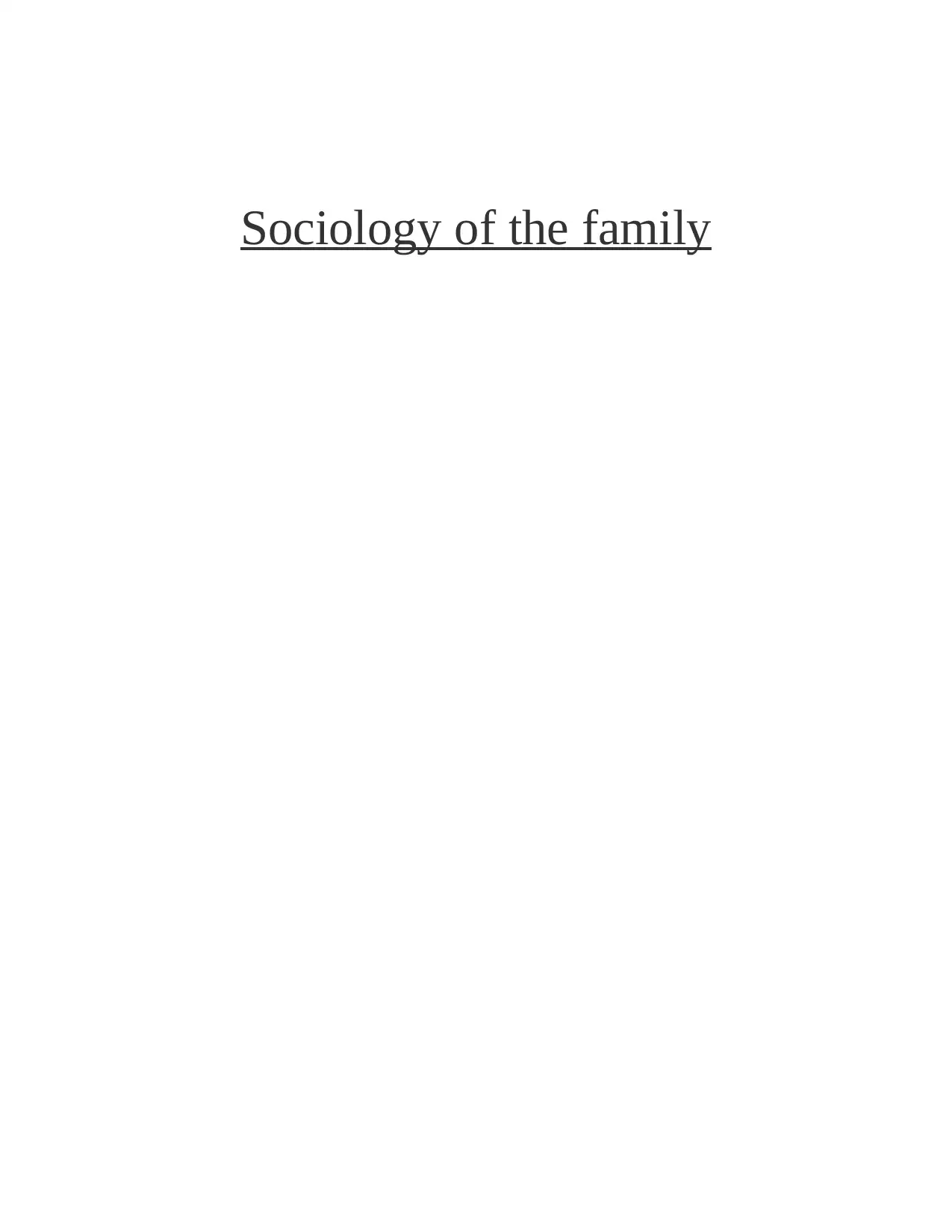
Sociology of the family
Paraphrase This Document
Need a fresh take? Get an instant paraphrase of this document with our AI Paraphraser
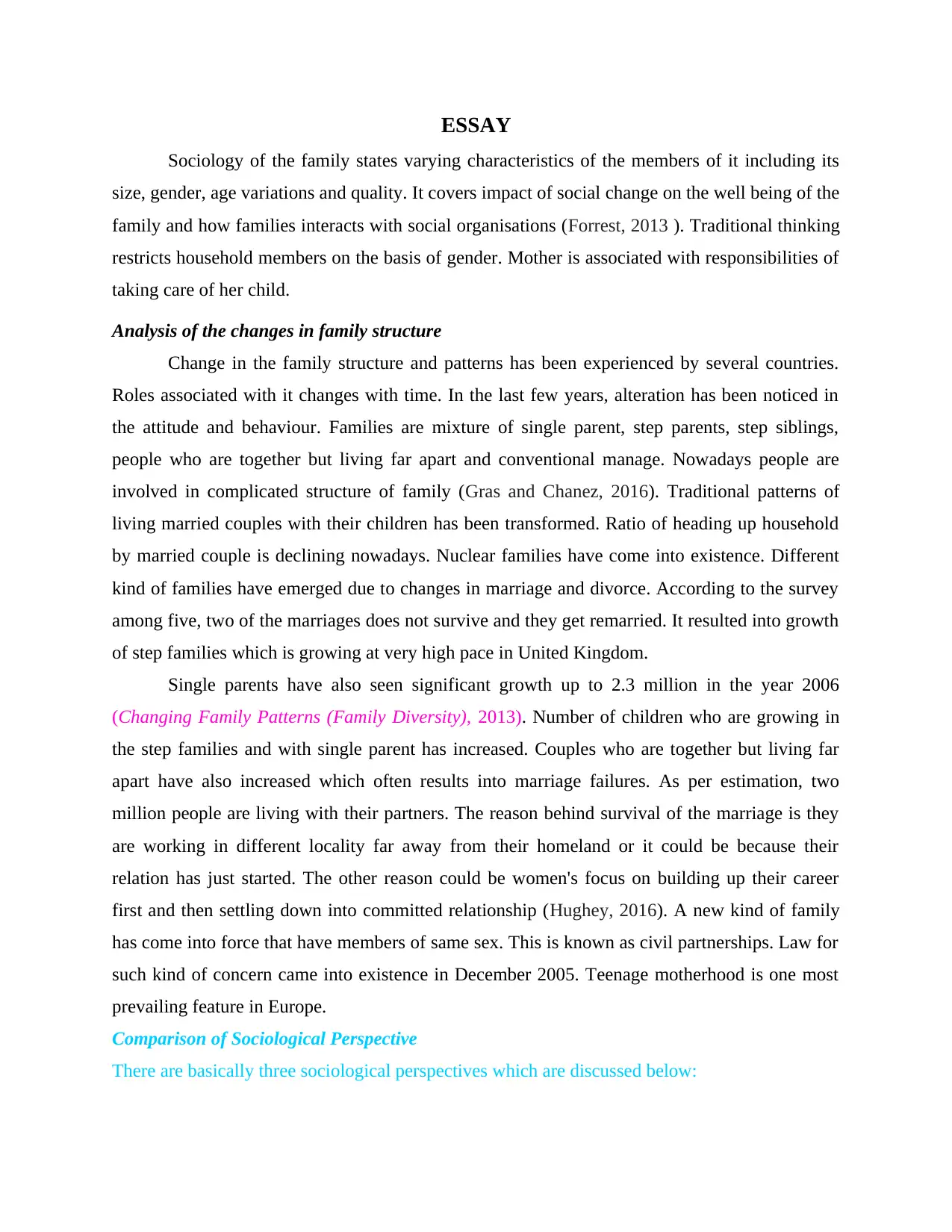
ESSAY
Sociology of the family states varying characteristics of the members of it including its
size, gender, age variations and quality. It covers impact of social change on the well being of the
family and how families interacts with social organisations (Forrest, 2013 ). Traditional thinking
restricts household members on the basis of gender. Mother is associated with responsibilities of
taking care of her child.
Analysis of the changes in family structure
Change in the family structure and patterns has been experienced by several countries.
Roles associated with it changes with time. In the last few years, alteration has been noticed in
the attitude and behaviour. Families are mixture of single parent, step parents, step siblings,
people who are together but living far apart and conventional manage. Nowadays people are
involved in complicated structure of family (Gras and Chanez, 2016). Traditional patterns of
living married couples with their children has been transformed. Ratio of heading up household
by married couple is declining nowadays. Nuclear families have come into existence. Different
kind of families have emerged due to changes in marriage and divorce. According to the survey
among five, two of the marriages does not survive and they get remarried. It resulted into growth
of step families which is growing at very high pace in United Kingdom.
Single parents have also seen significant growth up to 2.3 million in the year 2006
(Changing Family Patterns (Family Diversity), 2013). Number of children who are growing in
the step families and with single parent has increased. Couples who are together but living far
apart have also increased which often results into marriage failures. As per estimation, two
million people are living with their partners. The reason behind survival of the marriage is they
are working in different locality far away from their homeland or it could be because their
relation has just started. The other reason could be women's focus on building up their career
first and then settling down into committed relationship (Hughey, 2016). A new kind of family
has come into force that have members of same sex. This is known as civil partnerships. Law for
such kind of concern came into existence in December 2005. Teenage motherhood is one most
prevailing feature in Europe.
Comparison of Sociological Perspective
There are basically three sociological perspectives which are discussed below:
Sociology of the family states varying characteristics of the members of it including its
size, gender, age variations and quality. It covers impact of social change on the well being of the
family and how families interacts with social organisations (Forrest, 2013 ). Traditional thinking
restricts household members on the basis of gender. Mother is associated with responsibilities of
taking care of her child.
Analysis of the changes in family structure
Change in the family structure and patterns has been experienced by several countries.
Roles associated with it changes with time. In the last few years, alteration has been noticed in
the attitude and behaviour. Families are mixture of single parent, step parents, step siblings,
people who are together but living far apart and conventional manage. Nowadays people are
involved in complicated structure of family (Gras and Chanez, 2016). Traditional patterns of
living married couples with their children has been transformed. Ratio of heading up household
by married couple is declining nowadays. Nuclear families have come into existence. Different
kind of families have emerged due to changes in marriage and divorce. According to the survey
among five, two of the marriages does not survive and they get remarried. It resulted into growth
of step families which is growing at very high pace in United Kingdom.
Single parents have also seen significant growth up to 2.3 million in the year 2006
(Changing Family Patterns (Family Diversity), 2013). Number of children who are growing in
the step families and with single parent has increased. Couples who are together but living far
apart have also increased which often results into marriage failures. As per estimation, two
million people are living with their partners. The reason behind survival of the marriage is they
are working in different locality far away from their homeland or it could be because their
relation has just started. The other reason could be women's focus on building up their career
first and then settling down into committed relationship (Hughey, 2016). A new kind of family
has come into force that have members of same sex. This is known as civil partnerships. Law for
such kind of concern came into existence in December 2005. Teenage motherhood is one most
prevailing feature in Europe.
Comparison of Sociological Perspective
There are basically three sociological perspectives which are discussed below:
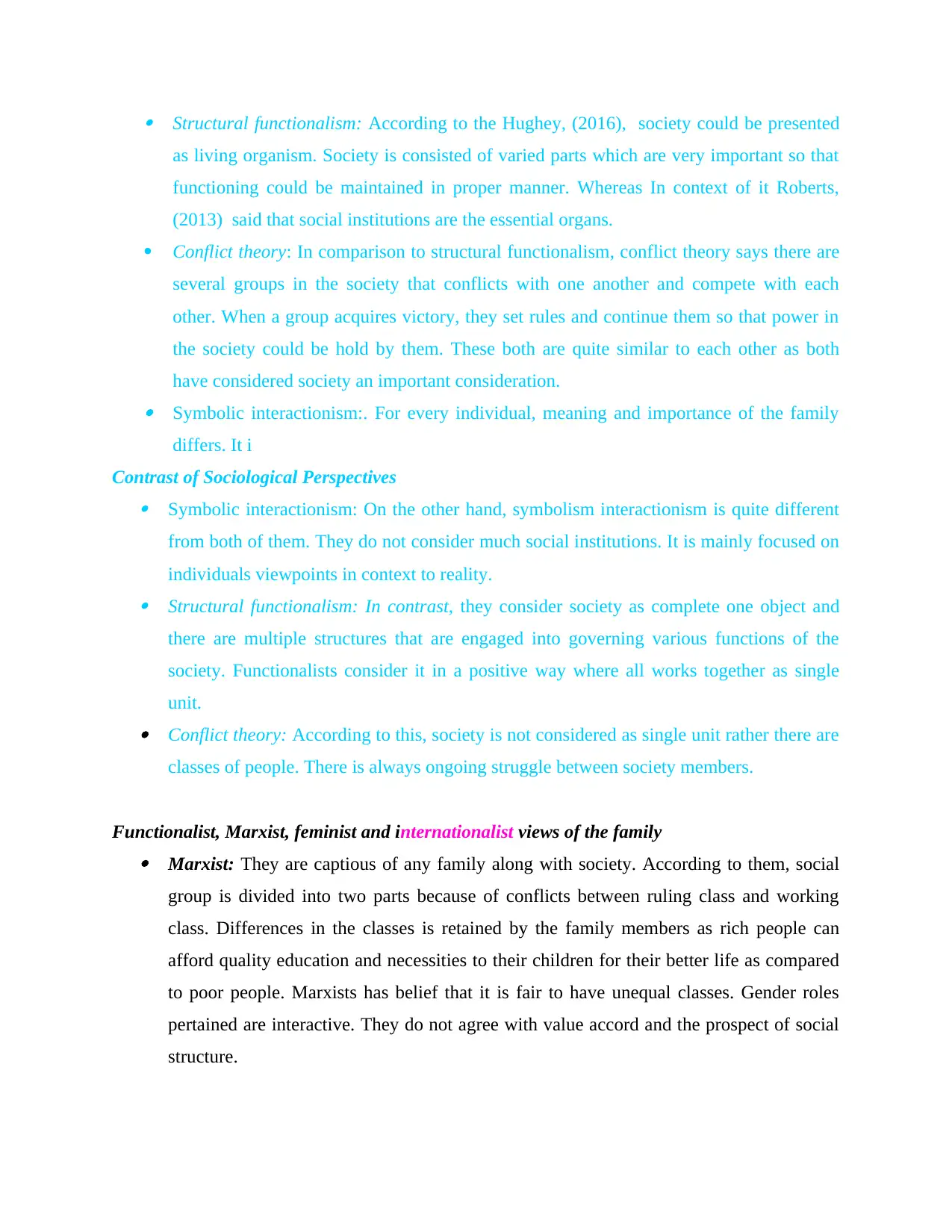
Structural functionalism: According to the Hughey, (2016), society could be presented
as living organism. Society is consisted of varied parts which are very important so that
functioning could be maintained in proper manner. Whereas In context of it Roberts,
(2013) said that social institutions are the essential organs.
Conflict theory: In comparison to structural functionalism, conflict theory says there are
several groups in the society that conflicts with one another and compete with each
other. When a group acquires victory, they set rules and continue them so that power in
the society could be hold by them. These both are quite similar to each other as both
have considered society an important consideration. Symbolic interactionism:. For every individual, meaning and importance of the family
differs. It i
Contrast of Sociological Perspectives Symbolic interactionism: On the other hand, symbolism interactionism is quite different
from both of them. They do not consider much social institutions. It is mainly focused on
individuals viewpoints in context to reality. Structural functionalism: In contrast, they consider society as complete one object and
there are multiple structures that are engaged into governing various functions of the
society. Functionalists consider it in a positive way where all works together as single
unit. Conflict theory: According to this, society is not considered as single unit rather there are
classes of people. There is always ongoing struggle between society members.
Functionalist, Marxist, feminist and internationalist views of the family Marxist: They are captious of any family along with society. According to them, social
group is divided into two parts because of conflicts between ruling class and working
class. Differences in the classes is retained by the family members as rich people can
afford quality education and necessities to their children for their better life as compared
to poor people. Marxists has belief that it is fair to have unequal classes. Gender roles
pertained are interactive. They do not agree with value accord and the prospect of social
structure.
as living organism. Society is consisted of varied parts which are very important so that
functioning could be maintained in proper manner. Whereas In context of it Roberts,
(2013) said that social institutions are the essential organs.
Conflict theory: In comparison to structural functionalism, conflict theory says there are
several groups in the society that conflicts with one another and compete with each
other. When a group acquires victory, they set rules and continue them so that power in
the society could be hold by them. These both are quite similar to each other as both
have considered society an important consideration. Symbolic interactionism:. For every individual, meaning and importance of the family
differs. It i
Contrast of Sociological Perspectives Symbolic interactionism: On the other hand, symbolism interactionism is quite different
from both of them. They do not consider much social institutions. It is mainly focused on
individuals viewpoints in context to reality. Structural functionalism: In contrast, they consider society as complete one object and
there are multiple structures that are engaged into governing various functions of the
society. Functionalists consider it in a positive way where all works together as single
unit. Conflict theory: According to this, society is not considered as single unit rather there are
classes of people. There is always ongoing struggle between society members.
Functionalist, Marxist, feminist and internationalist views of the family Marxist: They are captious of any family along with society. According to them, social
group is divided into two parts because of conflicts between ruling class and working
class. Differences in the classes is retained by the family members as rich people can
afford quality education and necessities to their children for their better life as compared
to poor people. Marxists has belief that it is fair to have unequal classes. Gender roles
pertained are interactive. They do not agree with value accord and the prospect of social
structure.
⊘ This is a preview!⊘
Do you want full access?
Subscribe today to unlock all pages.

Trusted by 1+ million students worldwide
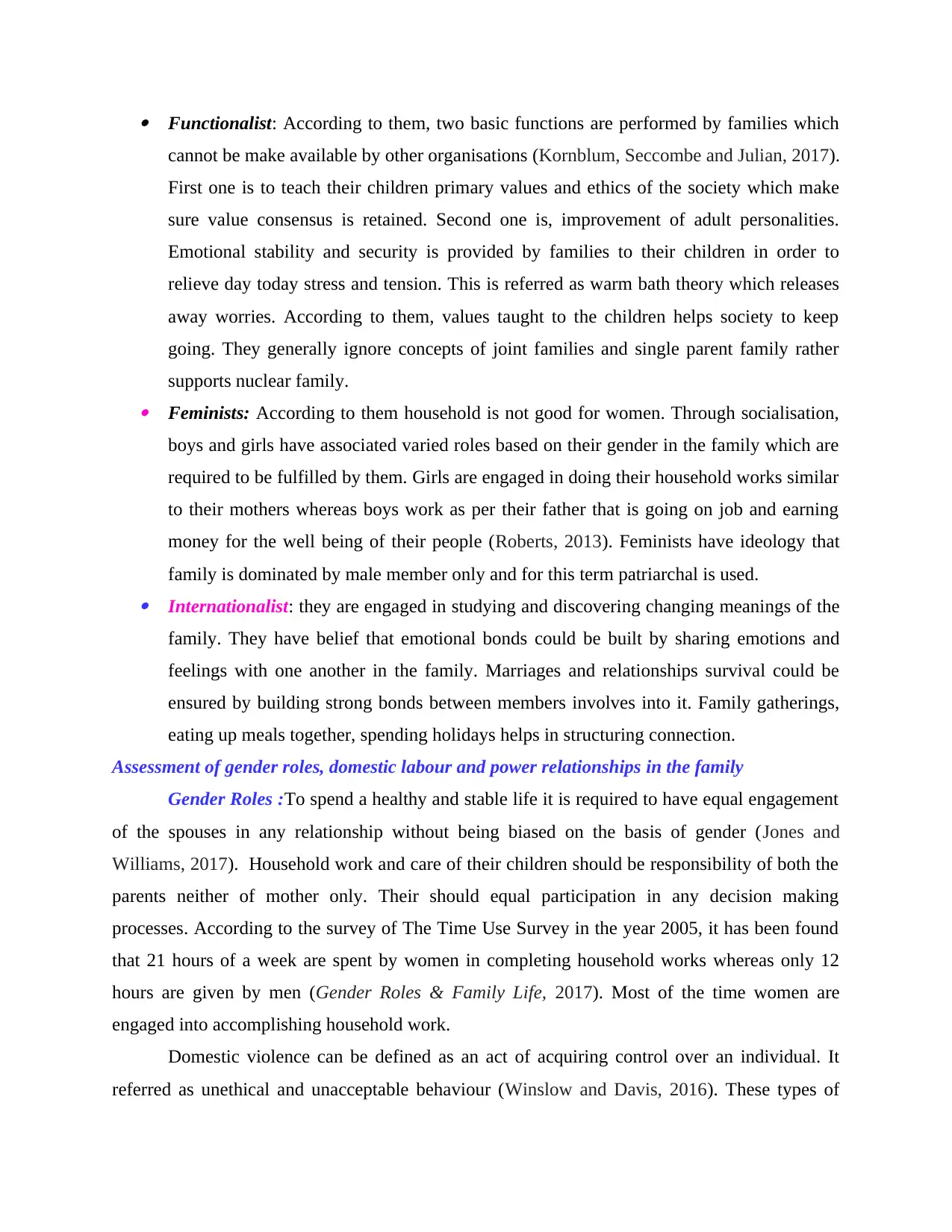
Functionalist: According to them, two basic functions are performed by families which
cannot be make available by other organisations (Kornblum, Seccombe and Julian, 2017).
First one is to teach their children primary values and ethics of the society which make
sure value consensus is retained. Second one is, improvement of adult personalities.
Emotional stability and security is provided by families to their children in order to
relieve day today stress and tension. This is referred as warm bath theory which releases
away worries. According to them, values taught to the children helps society to keep
going. They generally ignore concepts of joint families and single parent family rather
supports nuclear family. Feminists: According to them household is not good for women. Through socialisation,
boys and girls have associated varied roles based on their gender in the family which are
required to be fulfilled by them. Girls are engaged in doing their household works similar
to their mothers whereas boys work as per their father that is going on job and earning
money for the well being of their people (Roberts, 2013). Feminists have ideology that
family is dominated by male member only and for this term patriarchal is used. Internationalist: they are engaged in studying and discovering changing meanings of the
family. They have belief that emotional bonds could be built by sharing emotions and
feelings with one another in the family. Marriages and relationships survival could be
ensured by building strong bonds between members involves into it. Family gatherings,
eating up meals together, spending holidays helps in structuring connection.
Assessment of gender roles, domestic labour and power relationships in the family
Gender Roles :To spend a healthy and stable life it is required to have equal engagement
of the spouses in any relationship without being biased on the basis of gender (Jones and
Williams, 2017). Household work and care of their children should be responsibility of both the
parents neither of mother only. Their should equal participation in any decision making
processes. According to the survey of The Time Use Survey in the year 2005, it has been found
that 21 hours of a week are spent by women in completing household works whereas only 12
hours are given by men (Gender Roles & Family Life, 2017). Most of the time women are
engaged into accomplishing household work.
Domestic violence can be defined as an act of acquiring control over an individual. It
referred as unethical and unacceptable behaviour (Winslow and Davis, 2016). These types of
cannot be make available by other organisations (Kornblum, Seccombe and Julian, 2017).
First one is to teach their children primary values and ethics of the society which make
sure value consensus is retained. Second one is, improvement of adult personalities.
Emotional stability and security is provided by families to their children in order to
relieve day today stress and tension. This is referred as warm bath theory which releases
away worries. According to them, values taught to the children helps society to keep
going. They generally ignore concepts of joint families and single parent family rather
supports nuclear family. Feminists: According to them household is not good for women. Through socialisation,
boys and girls have associated varied roles based on their gender in the family which are
required to be fulfilled by them. Girls are engaged in doing their household works similar
to their mothers whereas boys work as per their father that is going on job and earning
money for the well being of their people (Roberts, 2013). Feminists have ideology that
family is dominated by male member only and for this term patriarchal is used. Internationalist: they are engaged in studying and discovering changing meanings of the
family. They have belief that emotional bonds could be built by sharing emotions and
feelings with one another in the family. Marriages and relationships survival could be
ensured by building strong bonds between members involves into it. Family gatherings,
eating up meals together, spending holidays helps in structuring connection.
Assessment of gender roles, domestic labour and power relationships in the family
Gender Roles :To spend a healthy and stable life it is required to have equal engagement
of the spouses in any relationship without being biased on the basis of gender (Jones and
Williams, 2017). Household work and care of their children should be responsibility of both the
parents neither of mother only. Their should equal participation in any decision making
processes. According to the survey of The Time Use Survey in the year 2005, it has been found
that 21 hours of a week are spent by women in completing household works whereas only 12
hours are given by men (Gender Roles & Family Life, 2017). Most of the time women are
engaged into accomplishing household work.
Domestic violence can be defined as an act of acquiring control over an individual. It
referred as unethical and unacceptable behaviour (Winslow and Davis, 2016). These types of
Paraphrase This Document
Need a fresh take? Get an instant paraphrase of this document with our AI Paraphraser
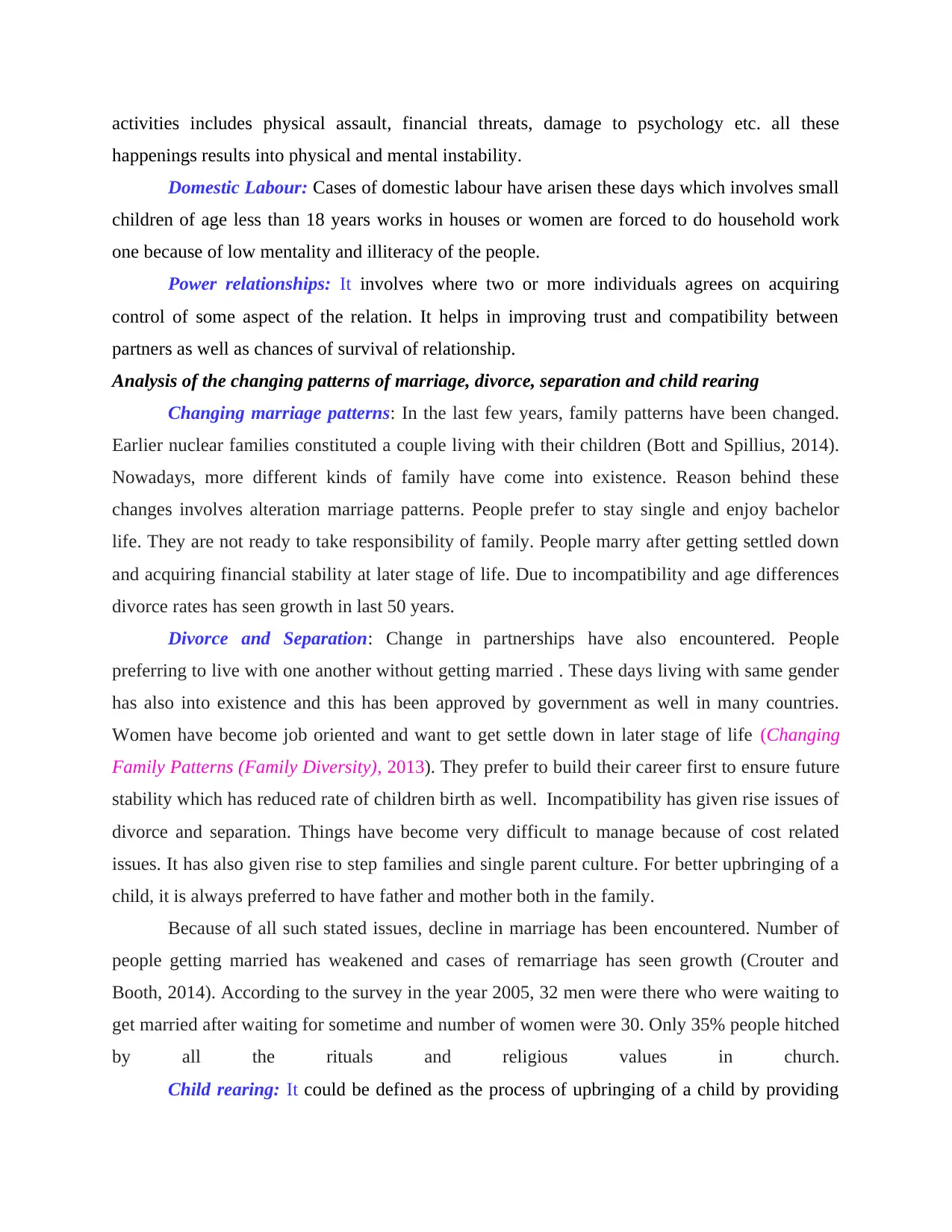
activities includes physical assault, financial threats, damage to psychology etc. all these
happenings results into physical and mental instability.
Domestic Labour: Cases of domestic labour have arisen these days which involves small
children of age less than 18 years works in houses or women are forced to do household work
one because of low mentality and illiteracy of the people.
Power relationships: It involves where two or more individuals agrees on acquiring
control of some aspect of the relation. It helps in improving trust and compatibility between
partners as well as chances of survival of relationship.
Analysis of the changing patterns of marriage, divorce, separation and child rearing
Changing marriage patterns: In the last few years, family patterns have been changed.
Earlier nuclear families constituted a couple living with their children (Bott and Spillius, 2014).
Nowadays, more different kinds of family have come into existence. Reason behind these
changes involves alteration marriage patterns. People prefer to stay single and enjoy bachelor
life. They are not ready to take responsibility of family. People marry after getting settled down
and acquiring financial stability at later stage of life. Due to incompatibility and age differences
divorce rates has seen growth in last 50 years.
Divorce and Separation: Change in partnerships have also encountered. People
preferring to live with one another without getting married . These days living with same gender
has also into existence and this has been approved by government as well in many countries.
Women have become job oriented and want to get settle down in later stage of life (Changing
Family Patterns (Family Diversity), 2013). They prefer to build their career first to ensure future
stability which has reduced rate of children birth as well. Incompatibility has given rise issues of
divorce and separation. Things have become very difficult to manage because of cost related
issues. It has also given rise to step families and single parent culture. For better upbringing of a
child, it is always preferred to have father and mother both in the family.
Because of all such stated issues, decline in marriage has been encountered. Number of
people getting married has weakened and cases of remarriage has seen growth (Crouter and
Booth, 2014). According to the survey in the year 2005, 32 men were there who were waiting to
get married after waiting for sometime and number of women were 30. Only 35% people hitched
by all the rituals and religious values in church.
Child rearing: It could be defined as the process of upbringing of a child by providing
happenings results into physical and mental instability.
Domestic Labour: Cases of domestic labour have arisen these days which involves small
children of age less than 18 years works in houses or women are forced to do household work
one because of low mentality and illiteracy of the people.
Power relationships: It involves where two or more individuals agrees on acquiring
control of some aspect of the relation. It helps in improving trust and compatibility between
partners as well as chances of survival of relationship.
Analysis of the changing patterns of marriage, divorce, separation and child rearing
Changing marriage patterns: In the last few years, family patterns have been changed.
Earlier nuclear families constituted a couple living with their children (Bott and Spillius, 2014).
Nowadays, more different kinds of family have come into existence. Reason behind these
changes involves alteration marriage patterns. People prefer to stay single and enjoy bachelor
life. They are not ready to take responsibility of family. People marry after getting settled down
and acquiring financial stability at later stage of life. Due to incompatibility and age differences
divorce rates has seen growth in last 50 years.
Divorce and Separation: Change in partnerships have also encountered. People
preferring to live with one another without getting married . These days living with same gender
has also into existence and this has been approved by government as well in many countries.
Women have become job oriented and want to get settle down in later stage of life (Changing
Family Patterns (Family Diversity), 2013). They prefer to build their career first to ensure future
stability which has reduced rate of children birth as well. Incompatibility has given rise issues of
divorce and separation. Things have become very difficult to manage because of cost related
issues. It has also given rise to step families and single parent culture. For better upbringing of a
child, it is always preferred to have father and mother both in the family.
Because of all such stated issues, decline in marriage has been encountered. Number of
people getting married has weakened and cases of remarriage has seen growth (Crouter and
Booth, 2014). According to the survey in the year 2005, 32 men were there who were waiting to
get married after waiting for sometime and number of women were 30. Only 35% people hitched
by all the rituals and religious values in church.
Child rearing: It could be defined as the process of upbringing of a child by providing
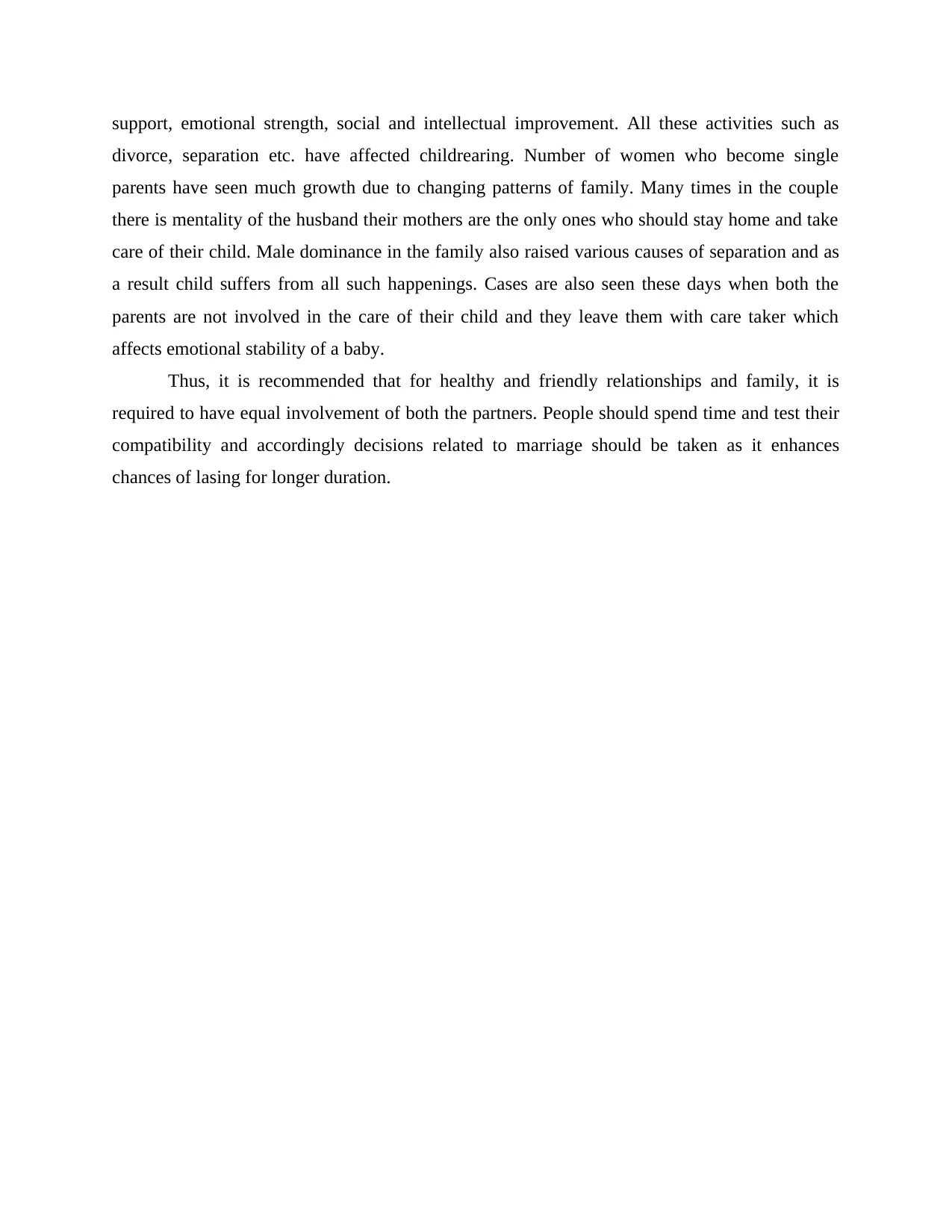
support, emotional strength, social and intellectual improvement. All these activities such as
divorce, separation etc. have affected childrearing. Number of women who become single
parents have seen much growth due to changing patterns of family. Many times in the couple
there is mentality of the husband their mothers are the only ones who should stay home and take
care of their child. Male dominance in the family also raised various causes of separation and as
a result child suffers from all such happenings. Cases are also seen these days when both the
parents are not involved in the care of their child and they leave them with care taker which
affects emotional stability of a baby.
Thus, it is recommended that for healthy and friendly relationships and family, it is
required to have equal involvement of both the partners. People should spend time and test their
compatibility and accordingly decisions related to marriage should be taken as it enhances
chances of lasing for longer duration.
divorce, separation etc. have affected childrearing. Number of women who become single
parents have seen much growth due to changing patterns of family. Many times in the couple
there is mentality of the husband their mothers are the only ones who should stay home and take
care of their child. Male dominance in the family also raised various causes of separation and as
a result child suffers from all such happenings. Cases are also seen these days when both the
parents are not involved in the care of their child and they leave them with care taker which
affects emotional stability of a baby.
Thus, it is recommended that for healthy and friendly relationships and family, it is
required to have equal involvement of both the partners. People should spend time and test their
compatibility and accordingly decisions related to marriage should be taken as it enhances
chances of lasing for longer duration.
⊘ This is a preview!⊘
Do you want full access?
Subscribe today to unlock all pages.

Trusted by 1+ million students worldwide

REFERENCES
Books and Journal
Bott, E., & Spillius, E. B. eds. (2014). Family and social network: Roles, norms and external
relationships in ordinary urban families. Routledge.
Cohen, P. N. (2016). Labor’s Love Lost: The Rise and Fall of the Working-Class Family in
America. Contemporary Sociology: A Journal of Reviews, 45(5), pp.586-587.
Crouter, A. C., & Booth, A. (2014). Work-family challenges for low-income parents and their
children. Routledge.
Forrest, R. (2013). Housing and family wealth. Routledge.
Gras, D., & Chanez, P. (2016). New sociology for better understanding severe eosinophilic
asthma: introducing the SOCS family. European Respiratory Journal, 48(3), 608-610.
Hughey, M. W. (2016). Sociology of the Family. Humanity & Society, 40(1), 86.
Jones, I. R. & Williams, G. (2017). Bourdieu, capitals and health. Sociology of health & illness,
39(1), pp.3-4.
Kornblum, W., Seccombe, K., & Julian, J. (2017). Social problems. Pearson.
Roberts, H. (2013). Doing feminist research. Routledge.
Winslow, S., & Davis, S. N. (2016). Gender Inequality Across the Academic Life Course.
Sociology Compass, 10(5), pp.404-416.
Online
Changing Family Patterns (Family Diversity), (2013). [Online]. Available through
<https://goffssociology.wordpress.com/changing-family-patterns-family-diversity/>.
[Accessed on 1st July 2017].
Gender Roles & Family Life, (2017). [Online]. Available through <https://revisionworld.com/a2-
level-level-revision/sociology-level-revision/family/gender-roles-family-life>. [Accessed
on 1st July 2017].
Books and Journal
Bott, E., & Spillius, E. B. eds. (2014). Family and social network: Roles, norms and external
relationships in ordinary urban families. Routledge.
Cohen, P. N. (2016). Labor’s Love Lost: The Rise and Fall of the Working-Class Family in
America. Contemporary Sociology: A Journal of Reviews, 45(5), pp.586-587.
Crouter, A. C., & Booth, A. (2014). Work-family challenges for low-income parents and their
children. Routledge.
Forrest, R. (2013). Housing and family wealth. Routledge.
Gras, D., & Chanez, P. (2016). New sociology for better understanding severe eosinophilic
asthma: introducing the SOCS family. European Respiratory Journal, 48(3), 608-610.
Hughey, M. W. (2016). Sociology of the Family. Humanity & Society, 40(1), 86.
Jones, I. R. & Williams, G. (2017). Bourdieu, capitals and health. Sociology of health & illness,
39(1), pp.3-4.
Kornblum, W., Seccombe, K., & Julian, J. (2017). Social problems. Pearson.
Roberts, H. (2013). Doing feminist research. Routledge.
Winslow, S., & Davis, S. N. (2016). Gender Inequality Across the Academic Life Course.
Sociology Compass, 10(5), pp.404-416.
Online
Changing Family Patterns (Family Diversity), (2013). [Online]. Available through
<https://goffssociology.wordpress.com/changing-family-patterns-family-diversity/>.
[Accessed on 1st July 2017].
Gender Roles & Family Life, (2017). [Online]. Available through <https://revisionworld.com/a2-
level-level-revision/sociology-level-revision/family/gender-roles-family-life>. [Accessed
on 1st July 2017].
Paraphrase This Document
Need a fresh take? Get an instant paraphrase of this document with our AI Paraphraser

1 out of 8
Related Documents
Your All-in-One AI-Powered Toolkit for Academic Success.
+13062052269
info@desklib.com
Available 24*7 on WhatsApp / Email
![[object Object]](/_next/static/media/star-bottom.7253800d.svg)
Unlock your academic potential
Copyright © 2020–2025 A2Z Services. All Rights Reserved. Developed and managed by ZUCOL.





